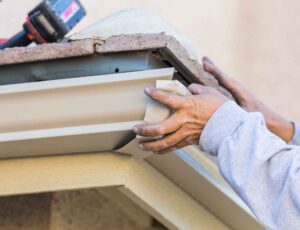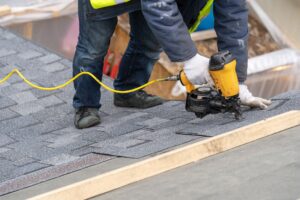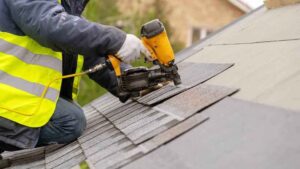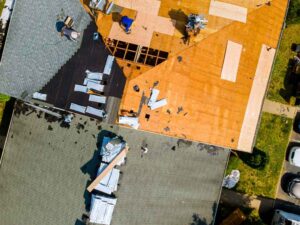If you’ve spent a few summers in the Midwest, you know how dry and heat-scorched they can get—like that year the fields outside the city were dust-gray by July, and every dry leaf felt like a fire risk. That’s why choosing the right Class A fire-resistant roofing materials isn’t just smart—it’s essential for homeowners who want roofing that lowers fire risk.
At Cornett Roofing Systems, we often hear questions like:
- What’s the best fire-resistant roofing material?
- Which non-combustible roofing materials perform best in our climate?
- How do I make sure my roof is truly fire-resistant?
This guide breaks it all down with local insight, 30+ years of experience, and trusted roofing expertise.
What You’ll Learn in This Guide
You’ll discover the best Class A fire-resistant roofing materials for dry Midwest summers, how installation affects fire safety, what maintenance looks like, and which options are right for your home. Plus, we’ll explain how fire risk really plays out in the Midwest—and why many homeowners are rethinking their roofing choices.
Why Fire-Resistant Roofing Matters in the Midwest
What Makes a Roof Fire-Resistant?
Roofing materials are classified into three fire resistance categories. Class A offers the highest level of protection against flame spread and radiant heat. Class B provides moderate resistance, while Class C is the minimum allowed by code in many areas. If you’re serious about safety, Class A is the standard to look for.
When Is Fire Risk Highest in the Midwest?
Fire safety might not be the first thing people associate with the Midwest, but local conditions tell a different story. Drought-prone summers, especially in states like Indiana, Illinois, and Ohio, dry out crops, leaves, and grass. Add in farm equipment sparks, open burn piles, unmanaged brush, and intense summer thunderstorms—and suddenly, fire risk becomes very real.
Even in suburban areas, wind-blown embers from a nearby field or lightning strike on a neighboring property can be enough to ignite an older, combustible roof. Homes located near wooded lots, grassy open fields, or farmland should take extra precautions with roofing that lowers fire risk.
What Should You Consider Before Choosing Fire-Resistant Roofing?
Fire-resistant roofing involves more than just the surface material. Yes, cost matters—metal and synthetic roofing materials are more expensive upfront than asphalt, but they can reduce long-term insurance premiums and maintenance costs.
You’ll also want to check local fire codes. Some areas in the Midwest now require Class A roofing materials, particularly in new subdivisions or homes built near open vegetation.
And don’t underestimate the importance of installation technique. Even the most fire-resistant roofing material can lose its rating if installed improperly. Proper venting, sealed penetrations, and fire-rated underlayment all contribute to your roof’s final fire classification.
Which Roofing Material Is Best for Fire Resistance?
Quick Answer:
The best fire-resistant roofing materials are Class A-rated metal roofing and synthetic slate, which are non-combustible, long-lasting, and highly effective at resisting embers and radiant heat in dry, high-risk areas.
How Does Metal Roofing Help Prevent Fire?
Metal roofing systems—such as steel or aluminum—are completely non-combustible and carry a Class A fire rating. They reflect heat, resist ember ignition, and reduce attic temperatures by up to 20°F. Many metal roofs also qualify as cool roofs, designed to reflect sunlight and absorb less heat. This dual benefit reduces both fire risk and overall heat load—key advantages during hot, dry Midwest summers.
At Cornett Roofing, we manufacture our own metal roofing systems right here in the Midwest, ensuring Class A-rated, custom-built protection that’s made to perform in our climate.
Metal is ideal for rural properties or homes near fields and trees. Maintenance is minimal, usually requiring just a yearly inspection for flashing and fasteners.
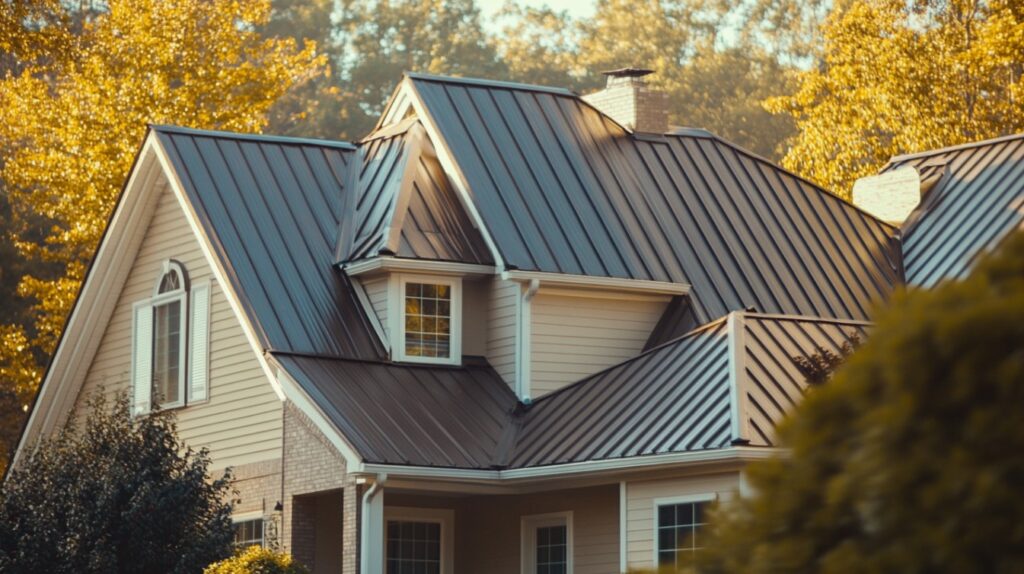
What Makes Synthetic Slate a Fire-Safe Option?
High-quality synthetic slate and tile systems mimic the look of traditional roofing while offering Class A fire protection. They’re lightweight, storm-resistant, and not as fragile as real slate. Maintenance includes clearing debris and checking underlayment every few years to maintain fire resistance.
When Do Treated Asphalt Shingles Make Sense?
Treated asphalt shingles can also achieve a Class A fire rating—but only if they’re factory-treated and installed with compliant underlayment. Over time, UV damage and weathering can degrade performance, so regular inspection is key.
This option is often a good fit for budget-conscious homeowners who still want a roof that reduces fire risk, though it comes with higher maintenance needs.
Not Sure Which Roof Type Is Right for Your Home?
Request a free fire-resistant roofing consultation
Our experts can recommend the safest material based on your location, budget, and goals.
How Does Installation Affect Fire Rating?
Proper installation is just as important as choosing a fire-resistant material. Your roofing system must include:
- Fire-rated underlayment
- Sealed flashing points
- Gaps sealed at vents and eaves
Even a non-combustible surface can lose its Class A fire rating if paired with poor venting design or incorrect underlayment.
At Cornett Roofing Systems, we use tested and certified fire-resistant underlayment that meets or exceeds building code. Our crews are trained to install to spec—ensuring your entire system stays Class A-rated.
How Do You Maintain a Fire-Resistant Roof?
Each material has different maintenance needs:
- Metal roofing: Annual inspection for fasteners and flashing
- Synthetic slate: Clear debris; check underlayment every few years
- Treated asphalt: Inspect every 2–3 years to monitor aging and performance
Maintenance ensures your fire resistance doesn’t degrade over time.
What If You Live Near Fields or Trees?
If your home is near dry fields, woods, or open rural land—especially in southern Indiana, central Illinois, or western Ohio—your risk is higher during fire season. Even a small brush fire can spread quickly under dry summer conditions.
Investing in Class A-rated roofing is a smart way to protect your home, meet code, and lower long-term risk.
Why Do Midwest Homeowners Choose Cornett Roofing?
We’ve served the Midwest for over 30 years, specializing in non-combustible, fire-resistant roofing systems built to withstand the region’s extreme heat and weather.
- Custom metal fabrication for fire and energy efficiency
- Synthetic slate and treated asphalt systems meeting fire code
- Licensed, insured crews
- Material and workmanship warranties covering fire-rated performance
Fire-Resistant Roofing FAQs for Midwest Homeowners
Which roofing type offers the best fire protection?
The roofing type that offers the best fire protection is a Class A-rated system, specifically metal roofing or synthetic slate, which are both non-combustible and highly effective at resisting flames, embers, and radiant heat.
Can fire-resistant roofing lower my insurance rates?
Yes, fire-resistant roofing can lower your insurance rates. Many insurance providers offer discounts for homes that use Class A fire-rated materials, especially in areas prone to drought, lightning storms, or nearby vegetation fires.
Is metal roofing loud during storms?
Metal roofing is not loud during storms when it is properly installed with solid decking and adequate insulation. The sound level is comparable to asphalt shingles or other traditional roofing materials.
What if I already have asphalt shingles?
If you already have asphalt shingles, it’s important to check whether they are Class A-rated and in good condition. Older or untreated shingles may not provide sufficient fire resistance and could require upgrading to a fire-resistant system.
Do fire-resistant roofs come with warranties?
Yes, fire-resistant roofs come with both material and workmanship warranties. At Cornett Roofing Systems, we offer full coverage on all fire-rated roofing systems, including metal, synthetic slate, and treated asphalt.
What’s the safest roofing for rural homes?
The safest roofing for rural homes is a Class A-rated system made from metal or synthetic slate, as these materials offer maximum protection against wind-blown embers, radiant heat, and wildland fires common near open fields or wooded areas.
How long do fire-resistant roofs last?
Fire-resistant roofs can last anywhere from 20 to 70 years, depending on the material. Metal roofs typically last 40–70 years, synthetic slate lasts 50+ years, and treated asphalt shingles last around 20–30 years with regular maintenance.
Does roofing underlayment affect fire resistance?
Yes, roofing underlayment plays a critical role in overall fire resistance. Even with a Class A-rated surface material, using non-rated or incompatible underlayment can compromise the entire fire rating of the roofing system.
Should I replace my roof just for fire protection?
Replacing your roof solely for fire protection may be a wise decision if your current roof is aging, made from combustible materials, or located in a high-risk area. Upgrading to a fire-resistant system adds long-term safety, especially in dry Midwest climates.
Ready to Protect Your Home With Fire-Resistant Roofing?
Fire-resistant roofing isn’t just about meeting code — it’s about protecting what matters most. If you’re ready to improve your home’s safety and durability, schedule a free fire-resistance inspection with Cornett Roofing Systems today.

